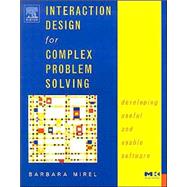
| Preface | xv | ||||
| Introductory Quotations | xv | ||||
| What is in This Book? | xvii | ||||
| How is This Book Organized? | xx | ||||
| Who Should Read This Book? | xxiii | ||||
| Acknowledgements | xxiv | ||||
| References | xxvi | ||||
| Introduction | xxvii | ||||
| What is Complex Problem Solving? | xxix | ||||
| Designing for Usefulness in the Whole Product | xxxi | ||||
| Putting Usefulness in the Center of Usability and Software Engineering | xxxii | ||||
| Where Does Interaction Design Come in? | xxxiii | ||||
| How far Along are We and are Useful Applications Possible? | xxxiv | ||||
| Setting the Stage | xxxvi | ||||
| Reference | xli | ||||
|
|||||
|
3 | (28) | |||
|
6 | (8) | |||
|
14 | (7) | |||
|
21 | (5) | |||
|
26 | (5) | |||
|
28 | (3) | |||
|
31 | (34) | |||
|
33 | (1) | |||
|
34 | (4) | |||
|
38 | (1) | |||
|
39 | (10) | |||
|
49 | (1) | |||
|
50 | (4) | |||
|
54 | (7) | |||
|
61 | (4) | |||
|
62 | (3) | |||
|
65 | (42) | |||
|
68 | (15) | |||
|
83 | (5) | |||
|
88 | (5) | |||
|
93 | (6) | |||
|
99 | (3) | |||
|
102 | (5) | |||
|
103 | (4) | |||
|
|||||
|
107 | (44) | |||
|
110 | (11) | |||
|
121 | (13) | |||
|
134 | (8) | |||
|
142 | (2) | |||
|
144 | (4) | |||
|
148 | (3) | |||
|
149 | (2) | |||
|
151 | (34) | |||
|
153 | (1) | |||
|
154 | (1) | |||
|
155 | (6) | |||
|
|||||
|
161 | (5) | |||
|
166 | (10) | |||
|
176 | (5) | |||
|
181 | (4) | |||
|
183 | (2) | |||
|
185 | (46) | |||
|
188 | (1) | |||
|
188 | (27) | |||
|
|||||
|
215 | (12) | |||
|
227 | (4) | |||
|
230 | (1) | |||
|
231 | (40) | |||
|
234 | (7) | |||
|
241 | (9) | |||
|
250 | (6) | |||
|
256 | (3) | |||
|
259 | (7) | |||
|
266 | (5) | |||
|
268 | (3) | |||
|
271 | (54) | |||
|
274 | (8) | |||
|
282 | (2) | |||
|
284 | (3) | |||
|
287 | (14) | |||
|
301 | (3) | |||
|
304 | (1) | |||
|
305 | (7) | |||
|
312 | (7) | |||
|
319 | (6) | |||
|
321 | (4) | |||
|
325 | (30) | |||
|
327 | (3) | |||
|
330 | (8) | |||
|
338 | (13) | |||
|
351 | (4) | |||
|
352 | (3) | |||
|
|||||
|
355 | (28) | |||
|
359 | (3) | |||
|
362 | (4) | |||
|
366 | (5) | |||
|
371 | (4) | |||
|
375 | (2) | |||
|
377 | (6) | |||
|
380 | (3) | |||
| Appendix | 383 | (2) | |||
| Figure Credits | 385 | (2) | |||
| Index | 387 |
The New copy of this book will include any supplemental materials advertised. Please check the title of the book to determine if it should include any access cards, study guides, lab manuals, CDs, etc.
The Used, Rental and eBook copies of this book are not guaranteed to include any supplemental materials. Typically, only the book itself is included. This is true even if the title states it includes any access cards, study guides, lab manuals, CDs, etc.